This is a Great Machete, Hatchet, and Work Out Routine in One Package
The Apex is a burly chopper with a surprisingly keen edge. It looks like something you slam against a rock to crack a nut for fun, but the ergonomics and the blade geometry give it a lot more utility past the typical brush clearing and drunken daring that’s standard with most machetes and big knives.
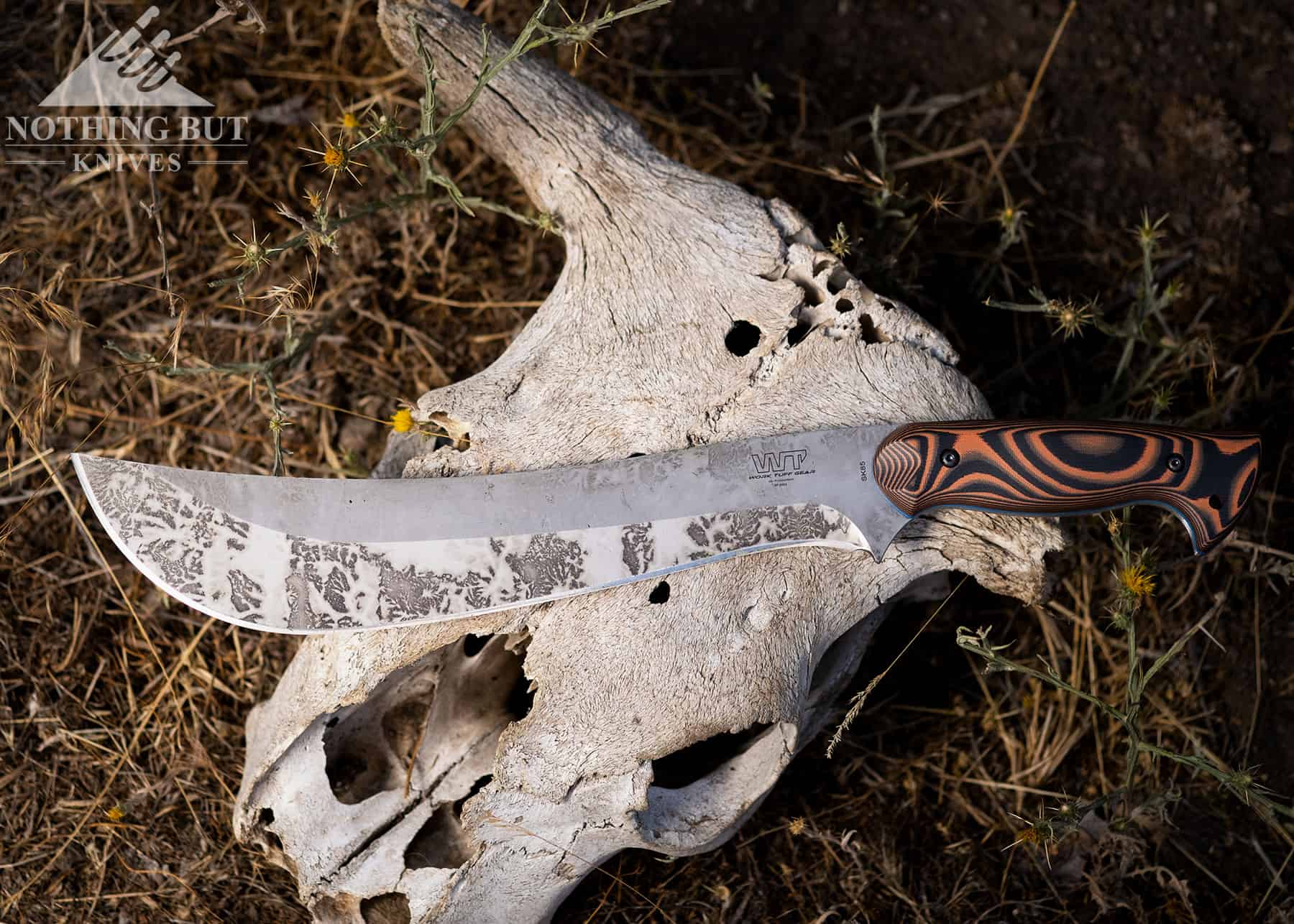
This is a heavy cutter and an efficient chopper with a big comfortable handle and a sturdy build that holds up to all kinds of heinous abuse. It can do so many different things on the campground from chopping branches and trailblazing to hammering in tent stakes and making kindling, but that utility comes in a hefty package.
Specifications
| Overall Length: | 18.2” |
| Blade Length: | 12.1” |
| Blade Steel: | SK85 |
| Hardness: | 56 – 58 HRC |
| Blade Thickness: | 0.23” (just under 6 mm) |
| Blade Shape: | Trailing point |
| Blade Grind: | Saber to convex edge |
| Handle Length: | 6.1” |
| Handle Material: | 3D G-10 |
| Weight: | 33 oz (about 2 lbs.) |
| Designer: | Julio Diez |
| Made in: | Taiwan |
Pros
| Fantastic chopper |
| A big comfortable handle with a lot of room for adjusting |
| Tough blade with great geometry |
| Likely to be the funnest tool in the garage |
Cons
| Heavy everywhere |
| Awkward to carry on the belt |
| Pretty expensive |
Work Tuff Folks
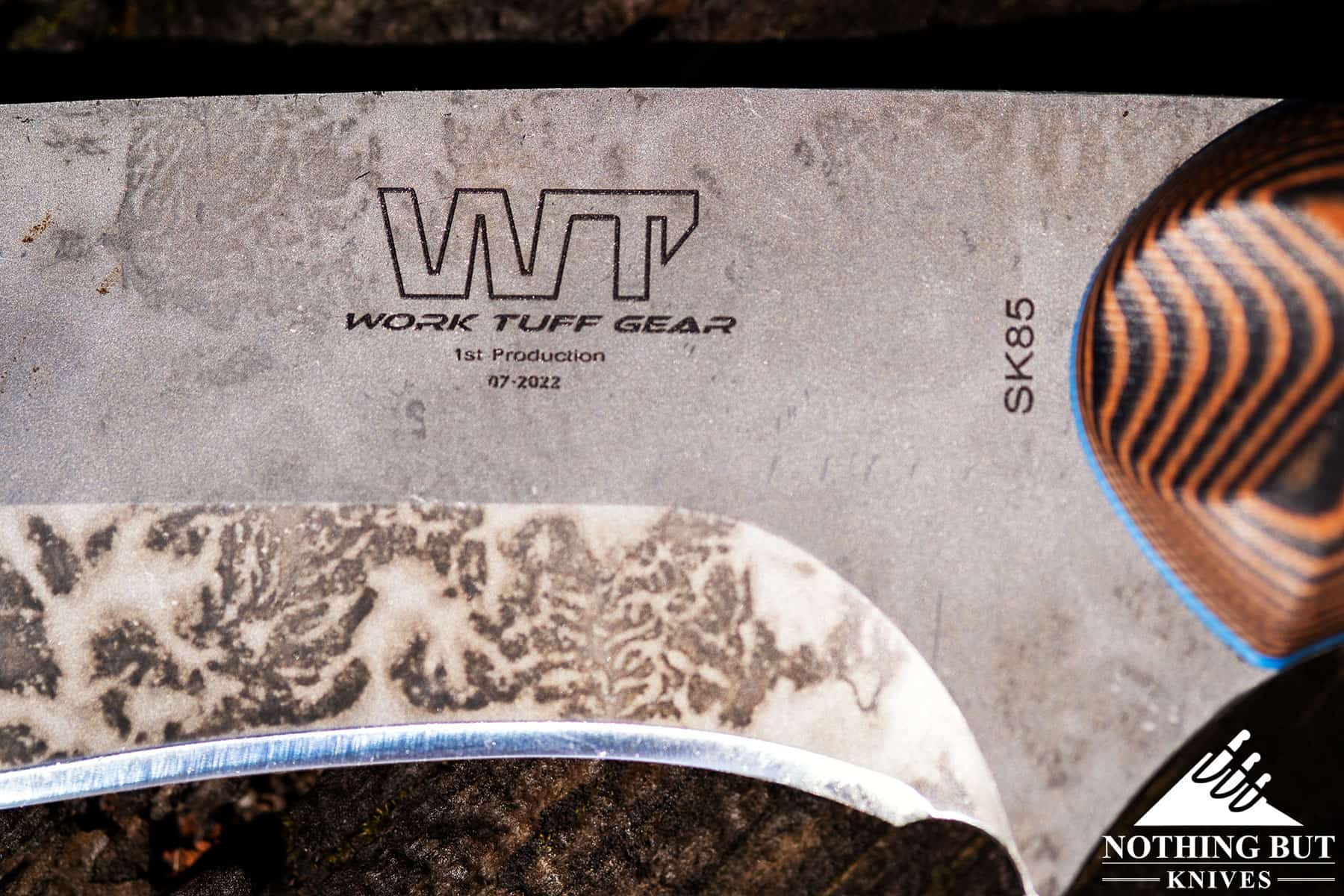
Work Tuff is a somewhat new company operating in Taiwan. They started up in 2018 with a mission statement to make purpose-driven outdoor tools. They use a spare selection of materials including G-10 and thick slabs of various tool and low alloy steels to make a range of tough camping and survival knives.
They remind me a lot of Condor knives to the degree that their knives tend to have very simple, efficient shapes with steel that isn’t trying to impress anyone. A marked difference is that Work Tuff has more designs pushing a modern-ish tactical styling rather than pure bushcraft. They make big shiny bowie knives with fullers, and skeletonized neck knives. We haven’t had a chance to test most of their line up yet, but looking at what they’ve made so far gives me a very strong “kid in the 90’s looking at a LEGO catalog” feeling.
Point being, it makes a lot of sense that Julio Diez is working with them now.
Fit, Finish, and Fun Things
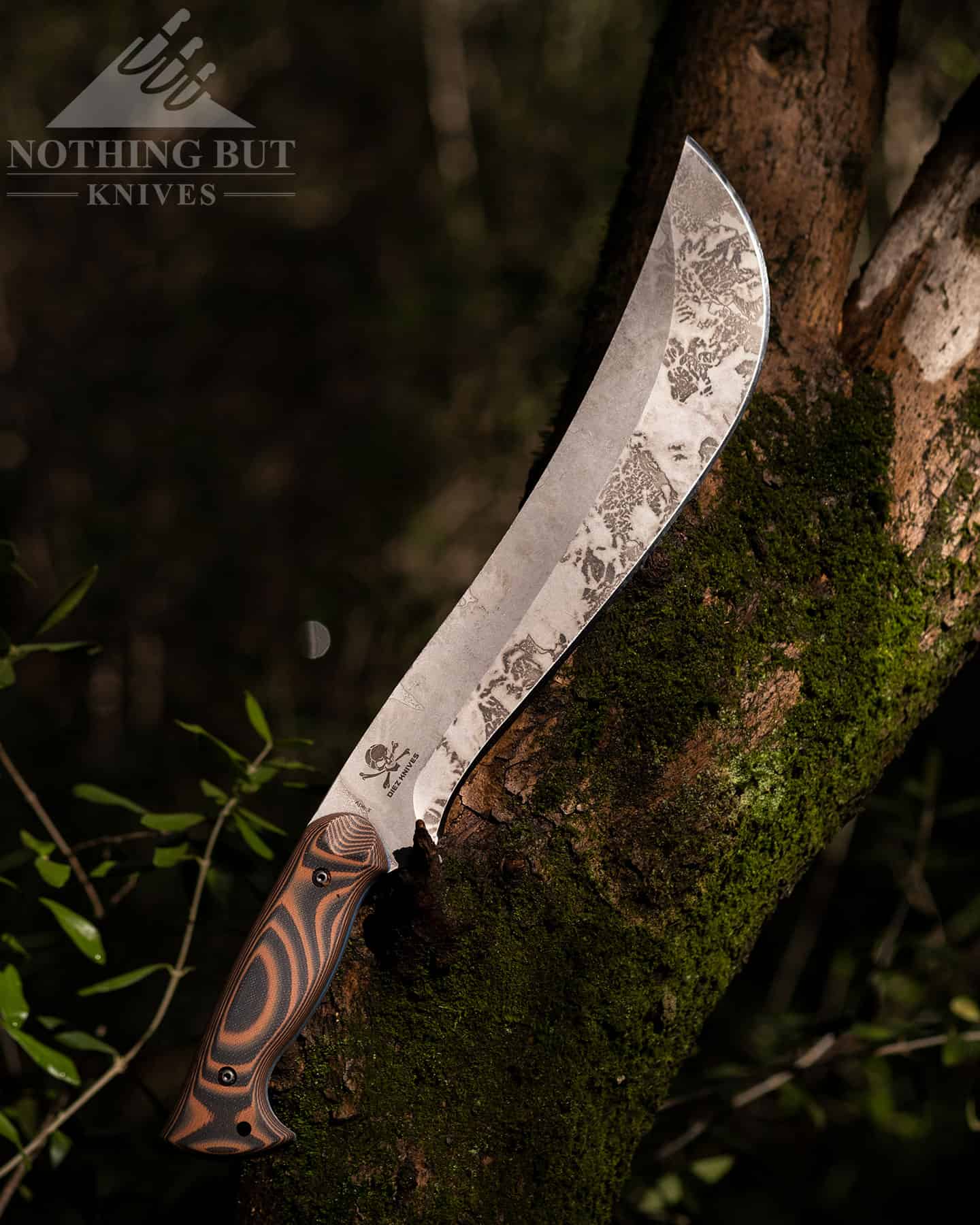
We received a preproduction model of this knife so we can’t exactly give you the whole skinny (or all the fat, in the case of this knife). But I can tell you that talking about fit and finish with a knife like this is sort of like discussing the finer points of plating a greasy hamburger.
Why do you care about the seamless transition between the tang and the scales? This is a giant piece of curvy, sharp steel that can cut branches in half with a single blow (or two, depending on the person swinging it).
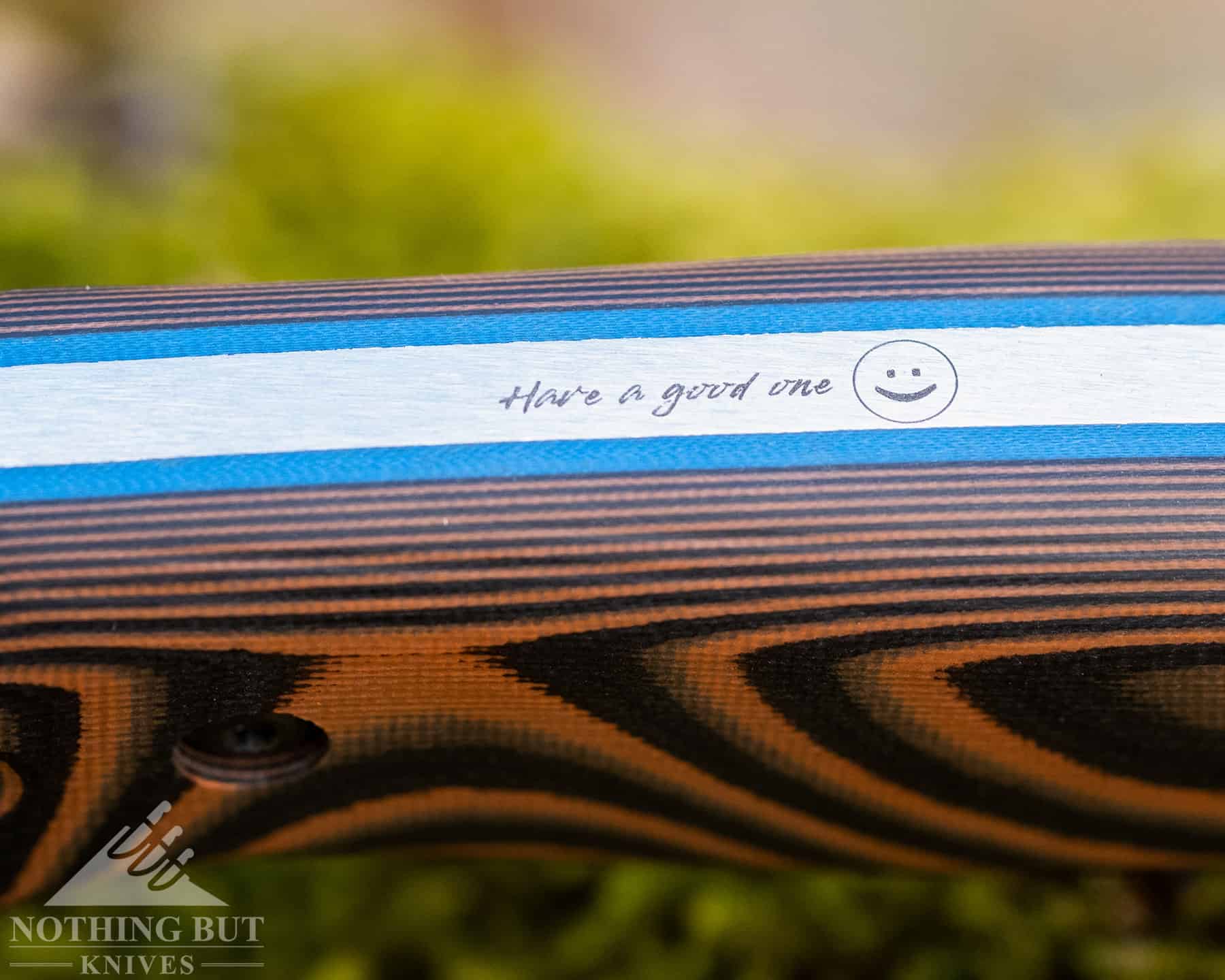
Don’t get me wrong. It’s cool that they put blue spacers in between the scales and the tang. It creates a really cool look for a knife that doesn’t really need to look nice in a way that doesn’t interfere with the function (or fun) of the design. The forced patina looks pretty nice too, in my opinion, and it seems to make the knife easier to clean.
The important part is that the Apex is well made. Everything fits together and stays together. There aren’t really any hotspots, and after a couple days of chopping up trees and clearing brush, all the screws are still tight, the edge is in good shape, and I still have all my fingers.
This Handle was Made for Swinging
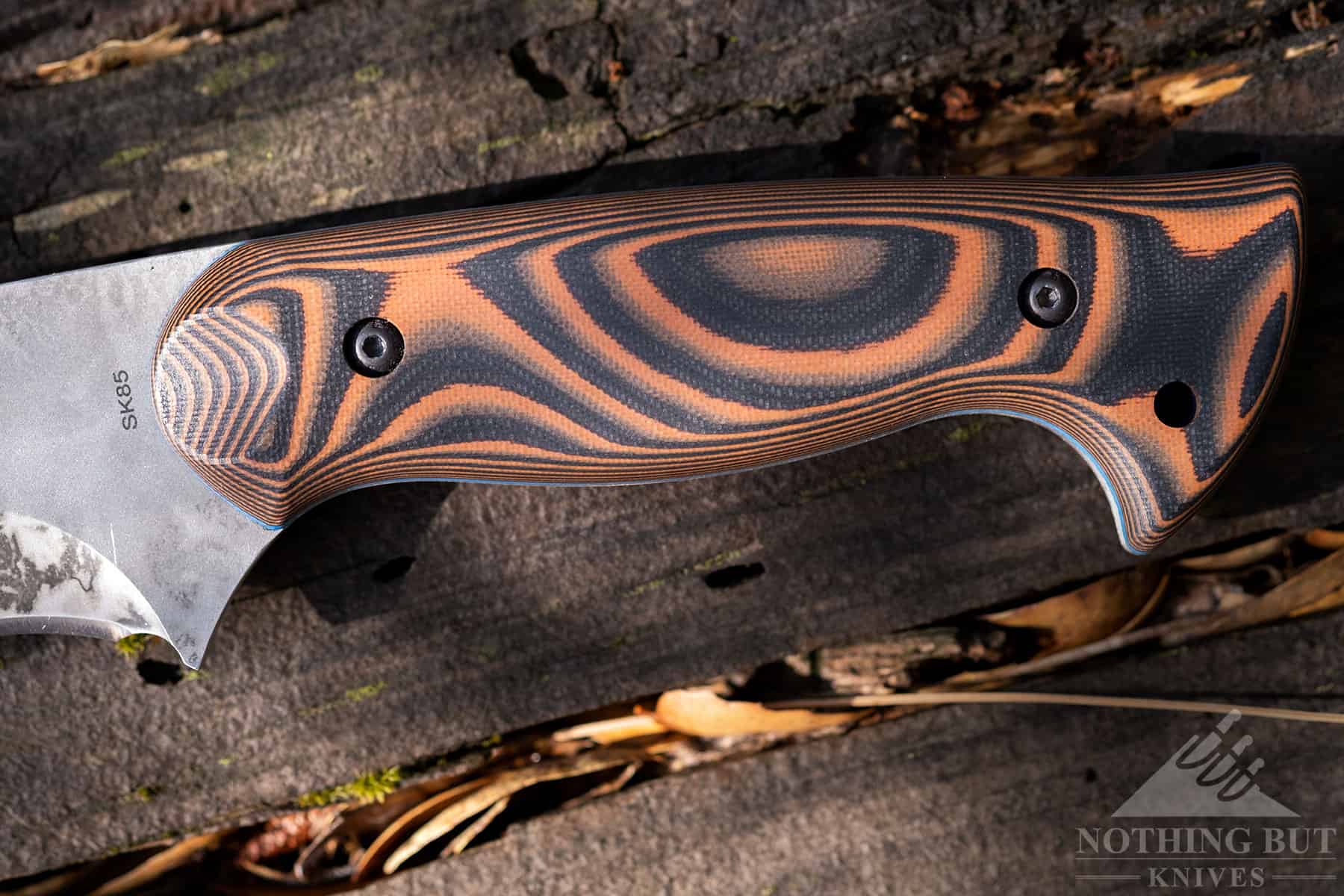
The G-10 has a fantastic grippy feeling that I would almost equate to Micarta, and the whole shape has a way of hugging the hand without making it feel trapped. As big as the knife is, the handle fits my hand surprisingly well. I can swing hard, but I still feel like I have good control and room to shift my grip as I need to.
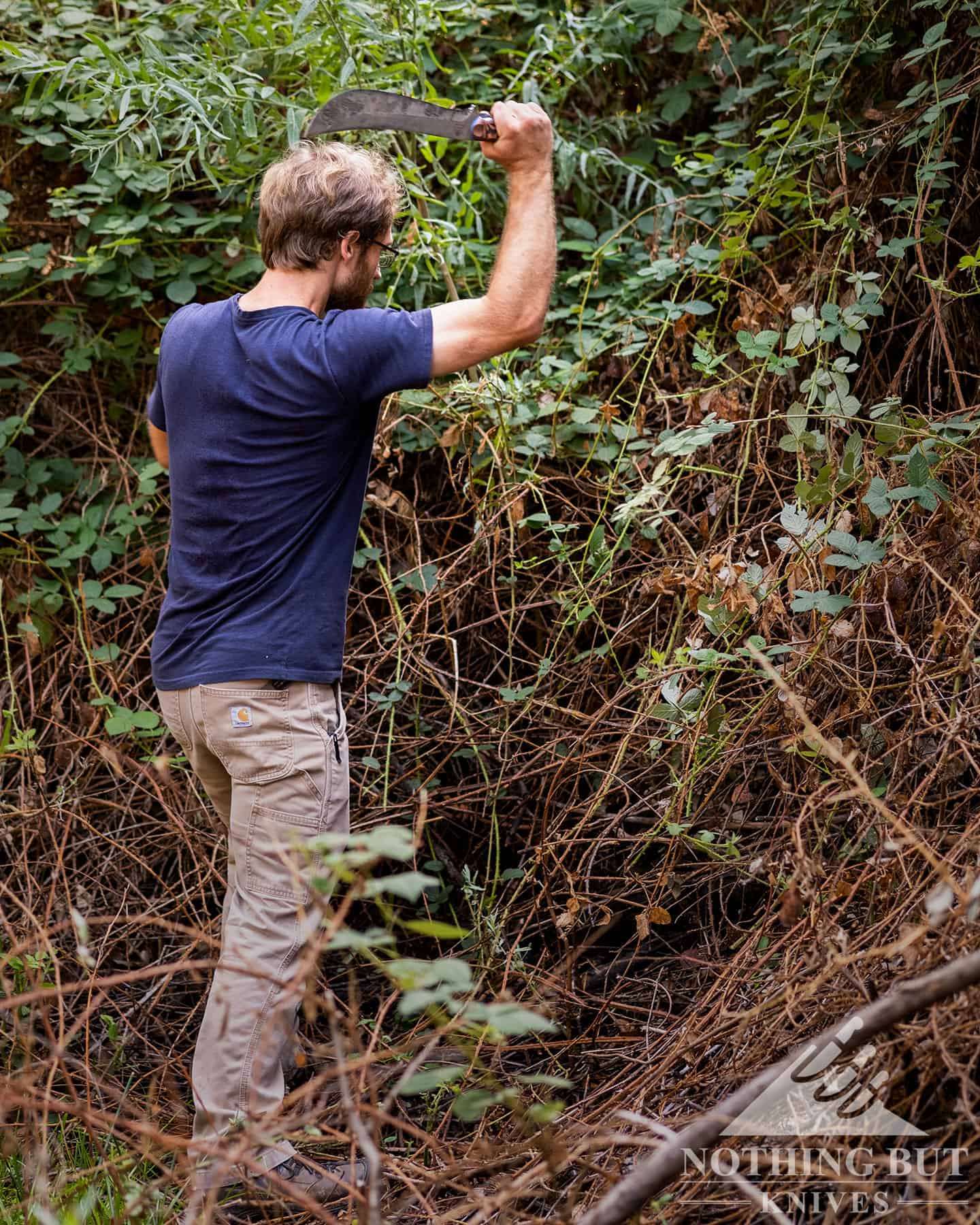
I was able to work my way through some thorny overgrowth without getting cut up too badly. The handle really makes it easy to control the angle of my swing (in spite of the weight), and the shape of the handle seems to index the edge with my knuckles well enough that I get the edge to go where I want it most of the time.
The ability to swing so securely from the bottom of the handle is a big benefit too when I really need that extra force, but I noticed that when I swing too many times consecutively from the bottom of the handle that my hand gets bunch up against the pommel and throws off my aim so the blade gets turned more often.
Fortunately I can get plenty of power to a swing holding the Apex normally. I only really swing from the pommel when I need to keep some distance between me and a thorny bush.
The Heavy Blade and Surprising Slicing Ability
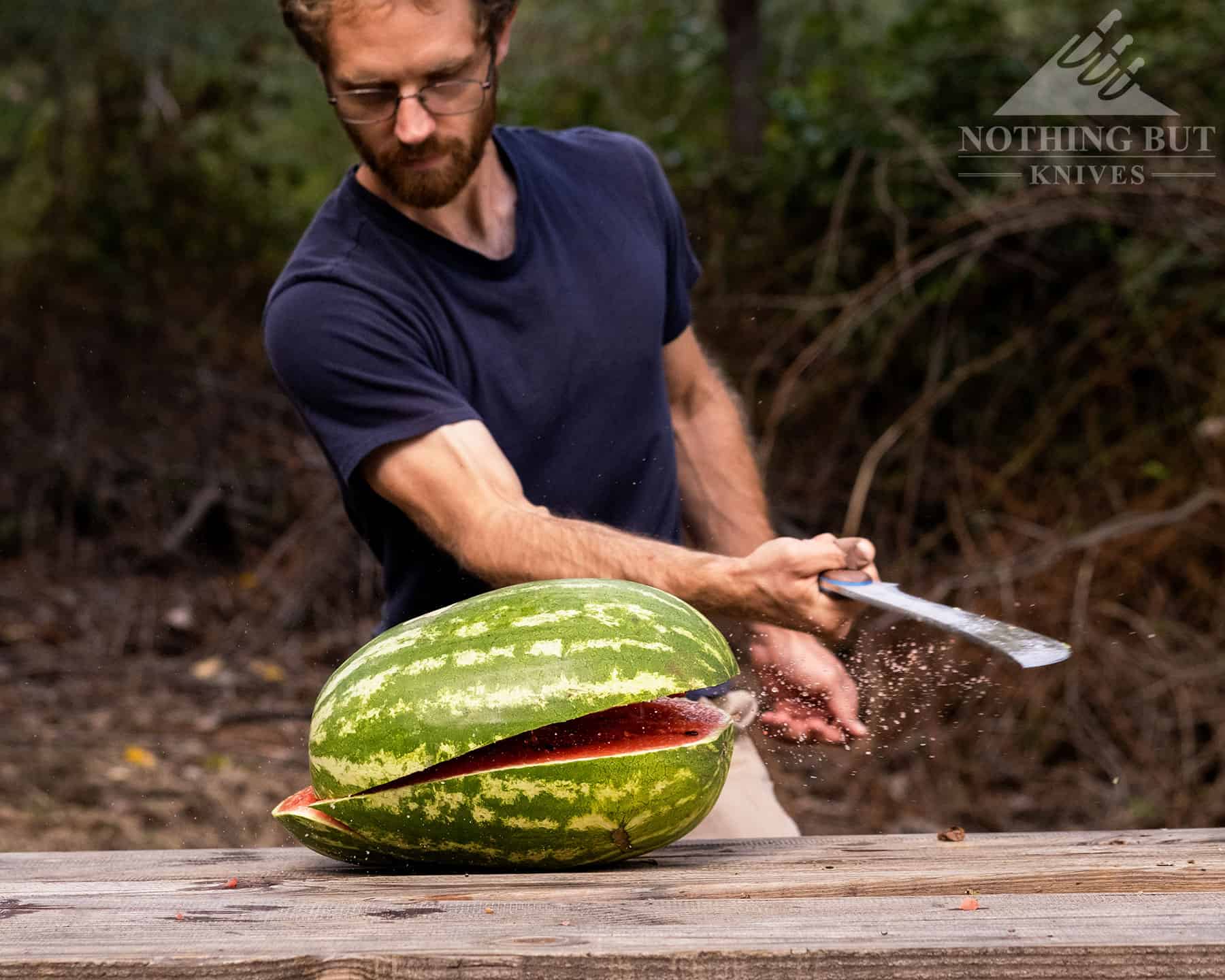
I typically go into testing a knife like this with a short list of expectations. I’m happy if it’s comfortable and can chop through a branch without it falling apart. I don’t expect a whole lot out of the edge except that it can handle a reasonable day’s work without chipping. If it can cut a free hanging rope, that’s great, but it’s not really something I need to do that often.
But I do not expect anything this thick to cut a freestanding melon in half.
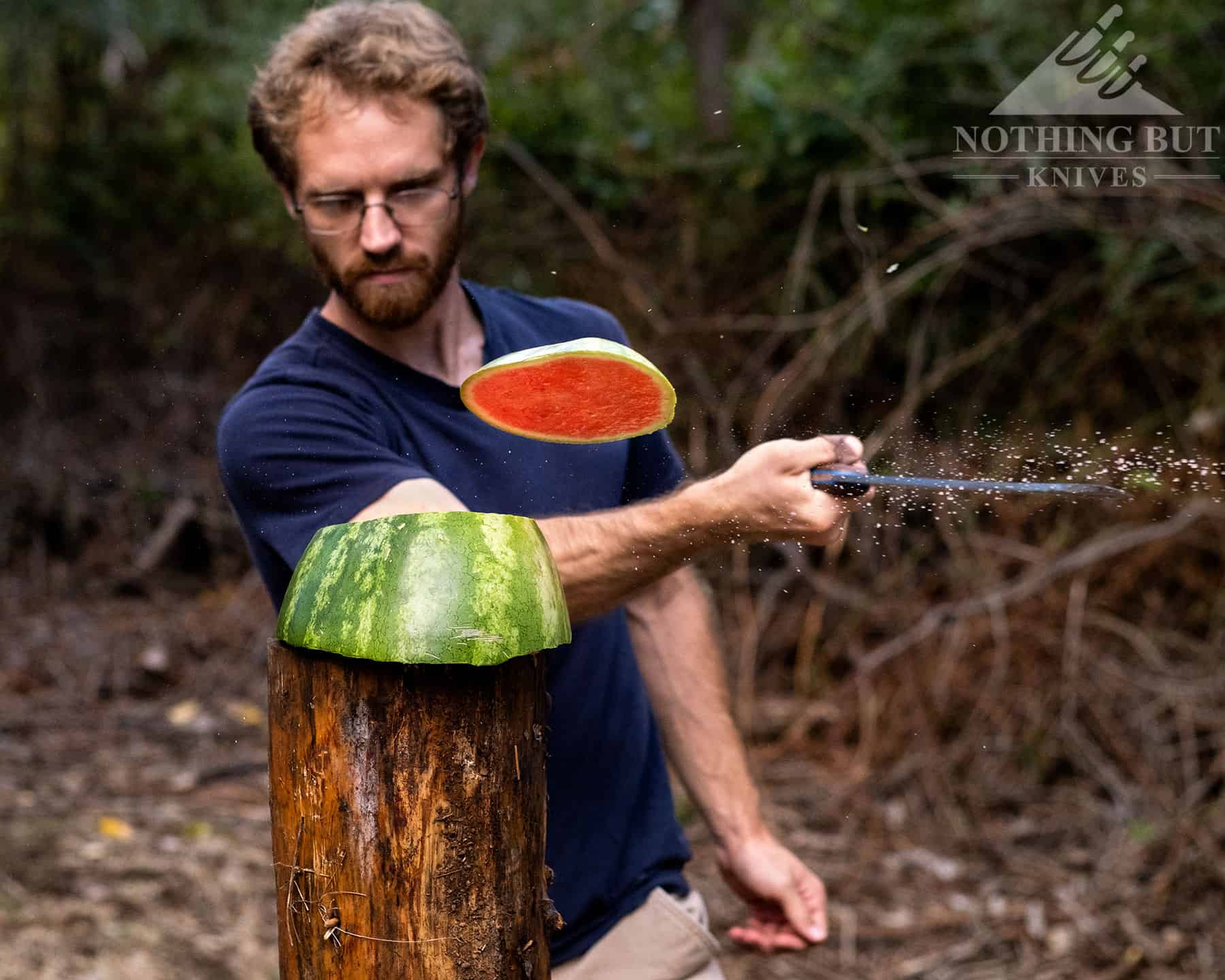
The practical applications of that only go so far, but it does show that there’s a little more finesse to the edge of the Apex than I thought was possible on a six millimeter blade stock. I was expecting to see a tree decorated with fruit by the end of the day, but not only does the cutting edge actually have a decent bite to it, but the slight convex with a big saber grind behind seems to be a perfect recipe for splitting all kinds of things whether they’re branches, ropes, or rotting watermelons (although batoning logs can be a problem, but more on that later).
That scimitar-adjacent trailing point shape also isn’t just for looks. It puts a big chunk of cutting edge in front of the knuckles and creates a long inward curve that kind of exaggerates a cut as you’re running something up the blade. It really feels like the shape is made well to make full use of the force of a swing.
It’s Still a Thick Blade Though
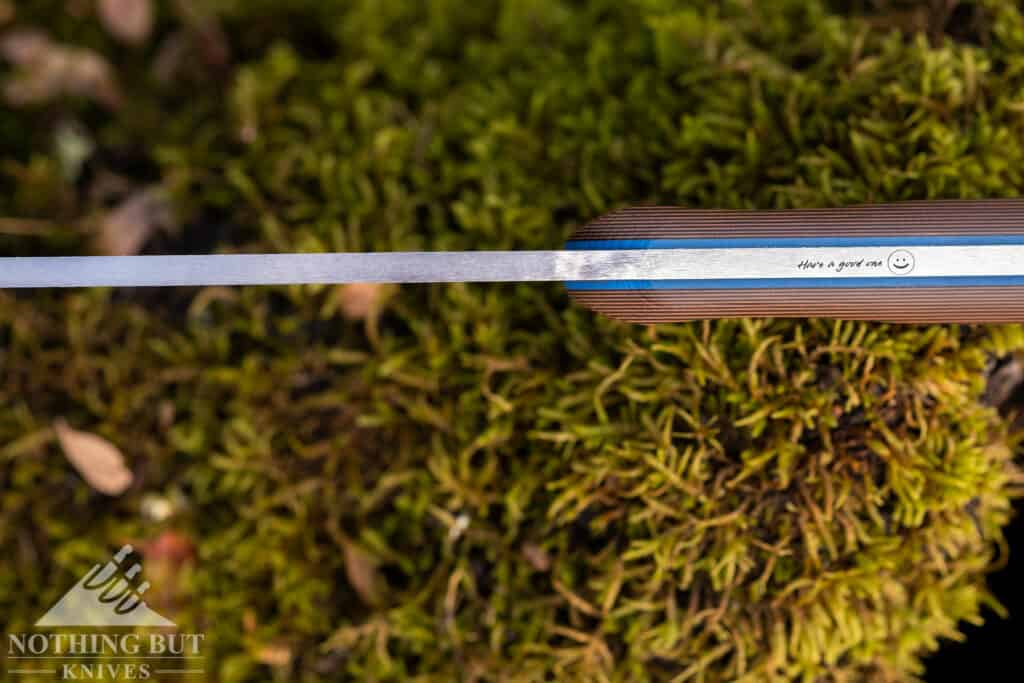
The grind of the blade was clearly geared toward toughness. A saber to convex grind puts a lot of sturdy material behind the cutting edge. It also leaves a huge chunk of steel around the spine that makes the blade pretty damn heavy. That’s great for chopping, but it’s not a blade for the faint of heart or the small of forearm (of course, using this enough will fix up the latter issue pretty quick).
While it can chop through a certain thickness pretty easily, if you try to cut through a long length of material it starts to feel more like a baseball bat.
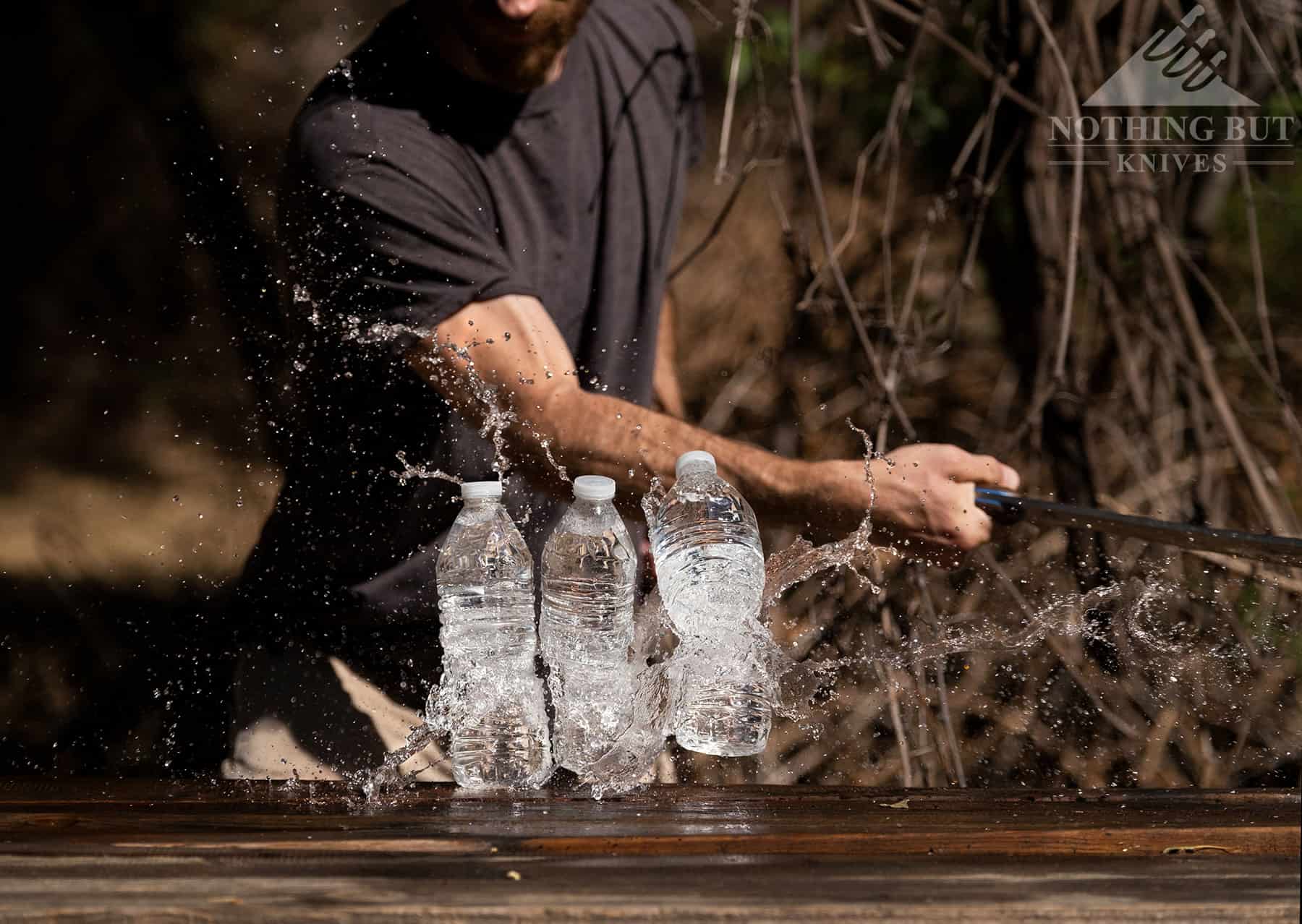
That’s something I discovered when we tried to see how many water bottles we could cut in a row with it. The Apex cuts through one or two just fine, but then the thickness catches and launches the rest of the line into the stratosphere. I imagine the same would happen if you tried cutting through cloth-like materials like tarps or blankets. It makes the cut just fine, but eventually that thickness will catch and interfere with the direction of the cut, especially if you’re in a hurry to cut a strip off a blanket or shirt to make a splint.
If you really want to make a long smooth cut with this blade, your best bet is to try cutting along the belly. That’s one of the many benefits of having that dramatic curve from a trailing point blade, but the weight and length of the Apex can make cuts like this feel pretty awkward.
The Steel and Edge Maintenance
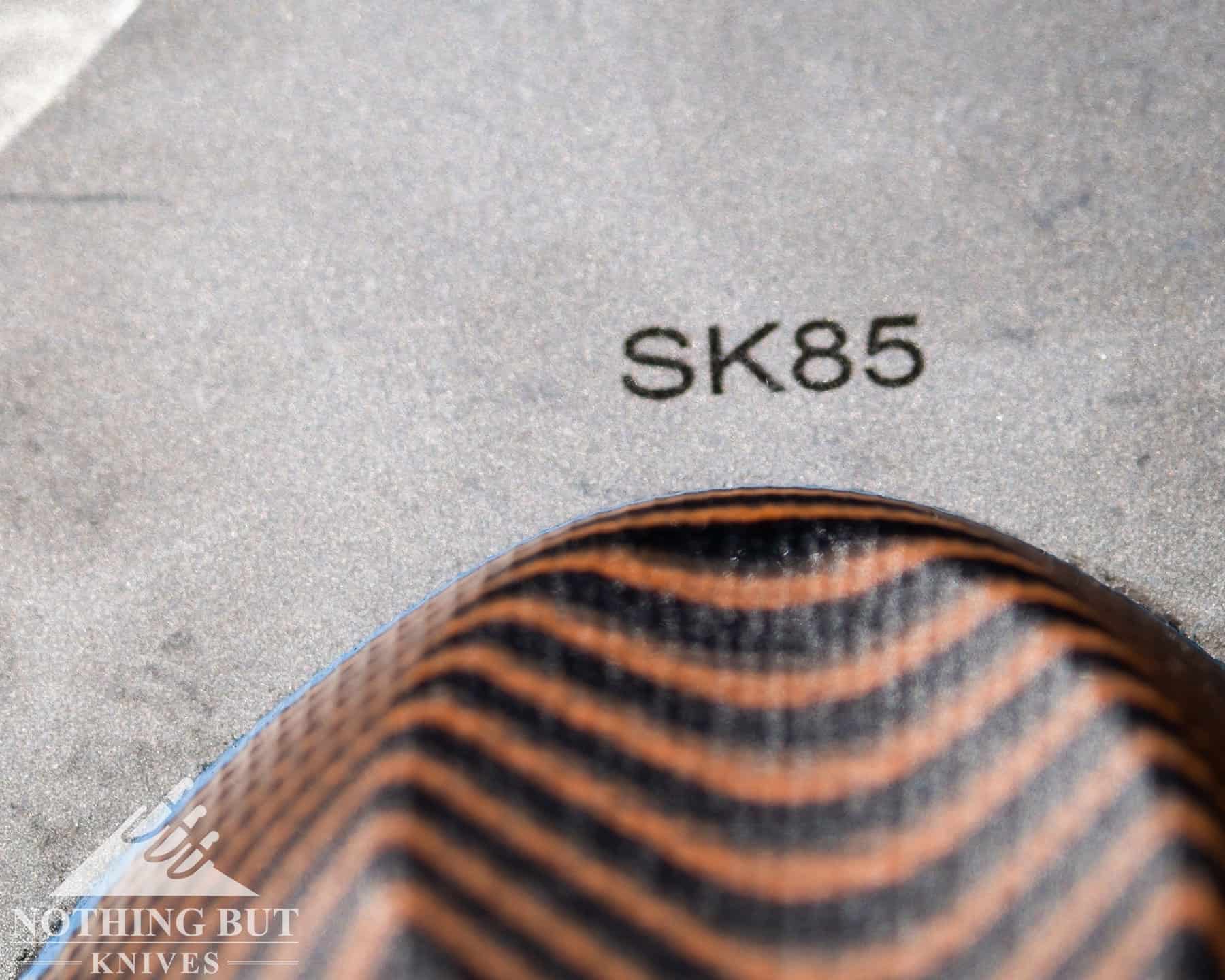
If you consider yourself a steel aficionado and you’re scratching your head at the steel name wondering if it’s a typo for SK5, you’re in good company. I was confused too, but it turns out SK85 steel is basically SK5 (so we don’t have to travel far, at least). Apparently JIS changed the name a few years ago, for… some reason.
Anyway, it’s a tough carbon steel that we’ve had some pretty good experiences with in the past. When it’s treated to a soft enough hardness (right in the 56 – 58 range like the Apex is) it’s incredibly tough and moderately easy to fix up in the field if you need to, although the recurve in the lower half of the blade comes with the typical complications of this blade shape.
Chopping and Bushcraft Things
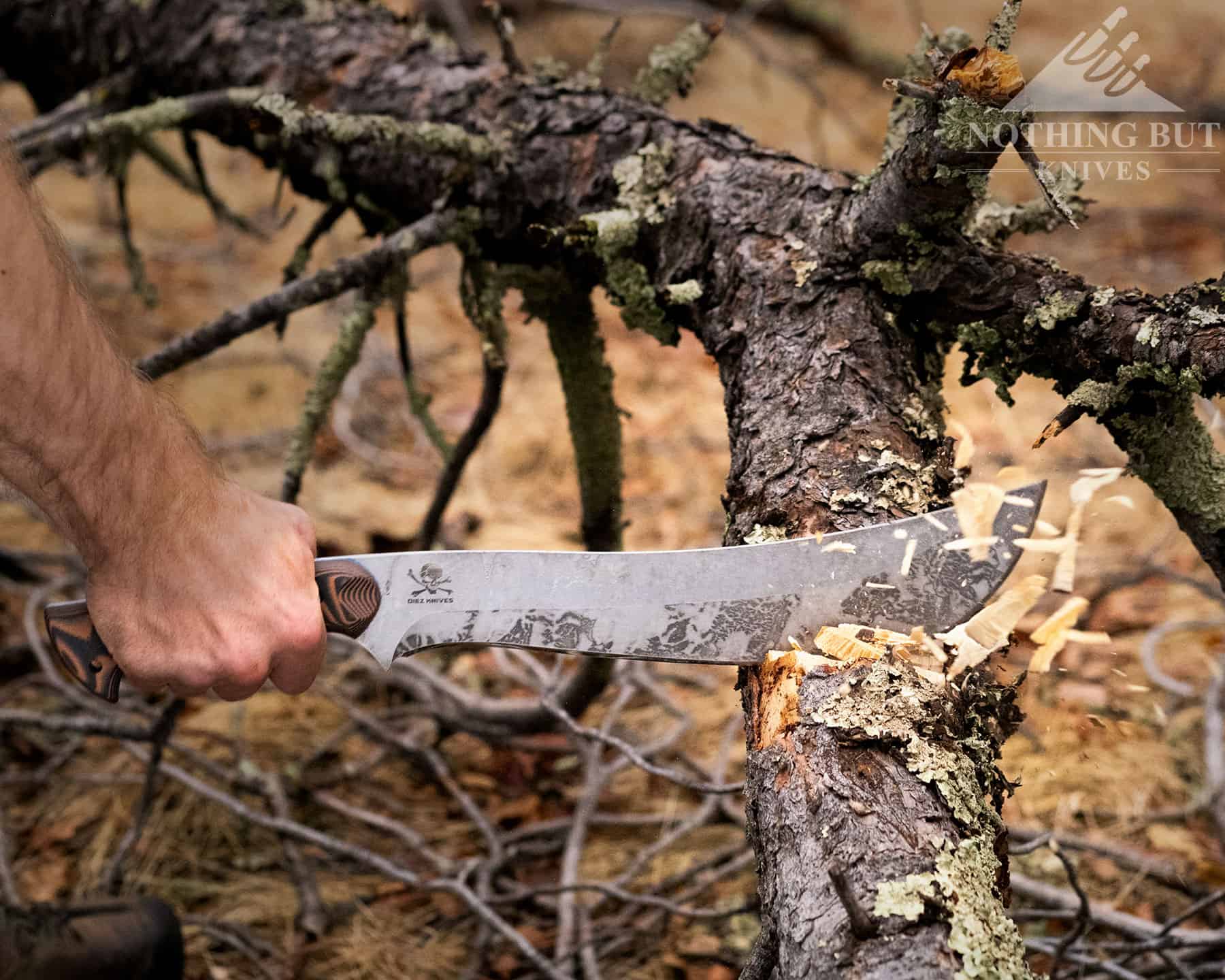
The Apex is great if you want to chop wood, but don’t expect to have a good time doing anything too fancy.
As expected, the wide, mostly convex grind takes chunks out of branches, which gives this thing something of a lumberjack quality. I didn’t notice any obvious chipping or rolling after chopping through the higher part of a fallen tree, and I was still able to do an hour or two of brush clearing afterwards, so the soft heat treatment on this blade is doing its job just fine.
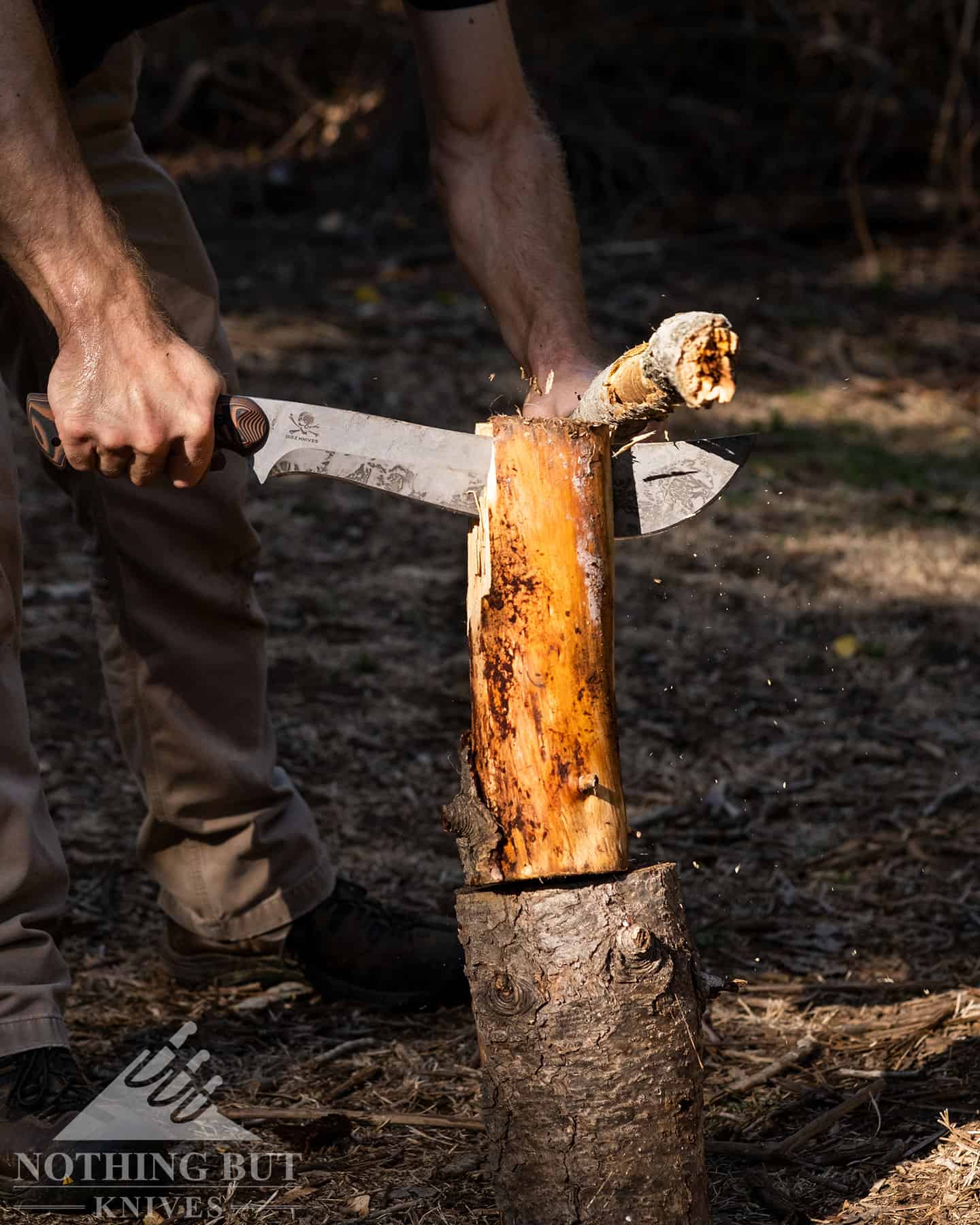
Surprisingly, I didn’t much like batoning with the Apex. This would do okay batoning a half log or smaller, but on a full round it runs into problems. The belly of the edge starts making a crack down one side of the log pretty quickly, but the inward curve gets stuck in the wood and makes the blade go in unevenly. I had to keep prying the knife out and restarting to try and keep the recurve out of the log.
I made quicker headway using this like an axe. I can get a pretty decent split started on a full log by just swinging the Apex into the top of the log. Then I can baton and pry the log apart easily enough to get a half. Then a good swing with the Apex can split smaller cuts of wood almost as easily as a hatchet.
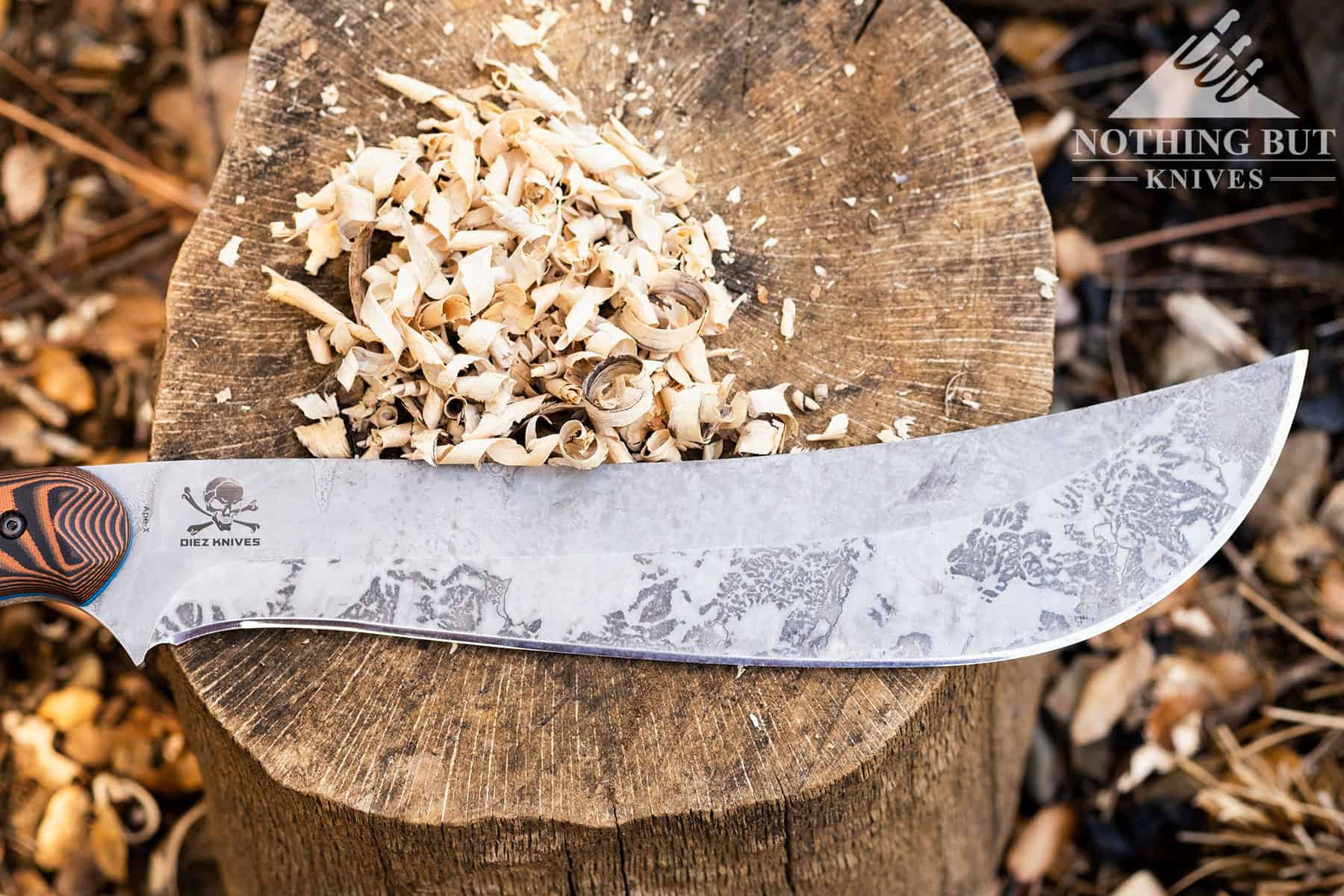
This is a pain to make feather sticks with, though. The grind does okay, but the weight and the recurve get in the way constantly. I could only really make usable tinder by running the length of the edge down a stick, and there was no chance of keeping the feathers connected.
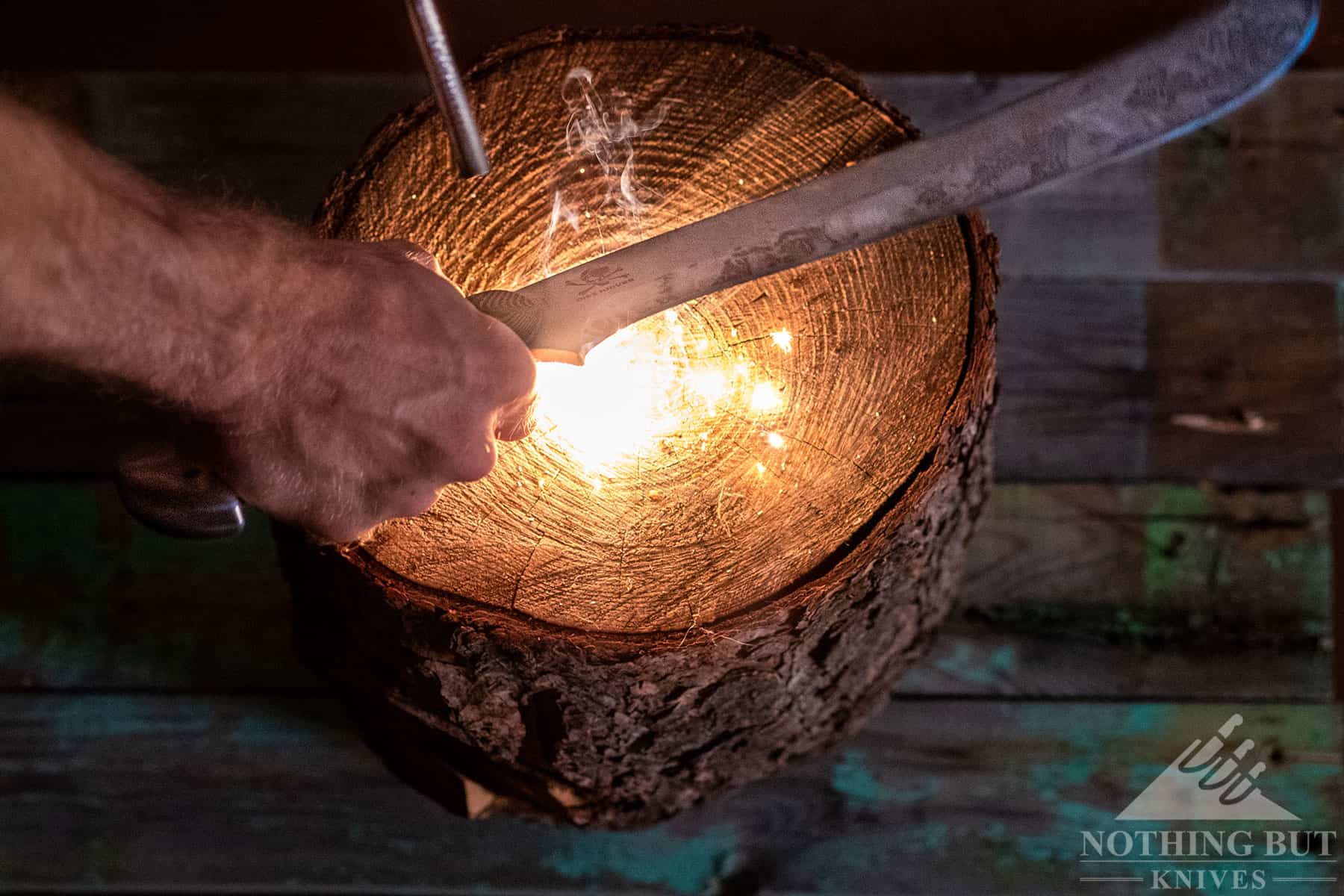
The spine throws sparks pretty well, but, again, the weight makes it kind of tiring. If the Apex was all I had to start a fire, I wouldn’t go cold, but I would be pretty damn sore before the day was over. But the truth I wouldn’t take the Apex out for starting fires anyway. The thing is like a manual chainsaw; the fact that I can start a fire with it if I really need to is just a little plus.
Hiking is Tricky Too
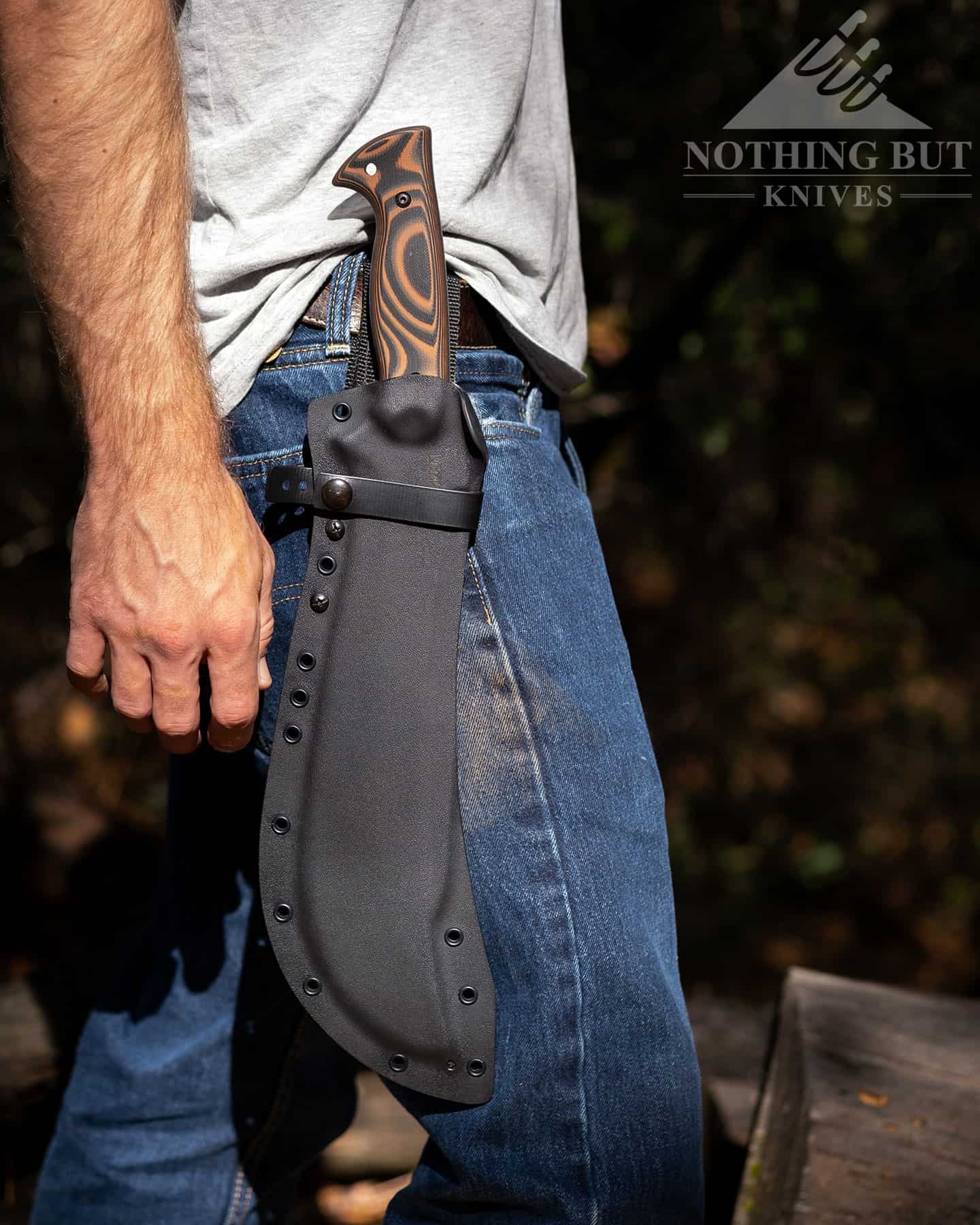
This thing was a drag on my belt and dainty hips, but before I go into criticizing anything too much here, I should emphasize that I do not have the build to carry this on my belt. I was also working with a pre-production sheath. I don’t know how much Work Tuff changed before rolling out the final version, but the early iteration of the sheath sagged pretty badly at my side and liked to bounce off my leg as I walked.
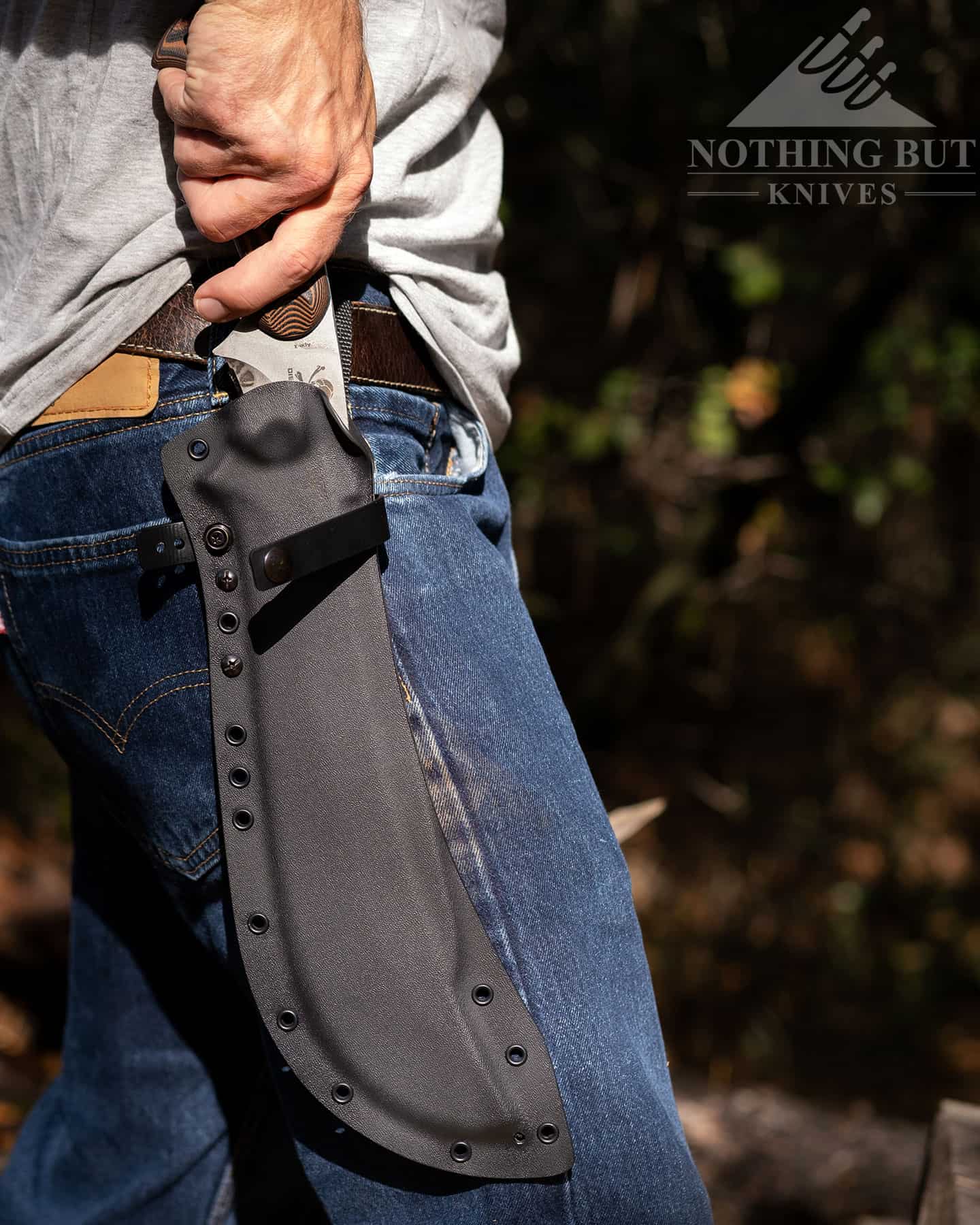
Drawing and sheathing a long curved blade is also tricky business no matter how well the sheath is made. I found the easiest way to get it back into the sheath was to hold the Apex in a sort of reverse ice pick. It was easier to guide the blade in that way without having to get my other hand involved.
It looks like Work Tuff is shipping the full production version with a shoulder strap attached to the sheath. That seems like a good solution to a problem that doesn’t have many good work arounds. This would be a lot nicer to carry on my back, especially since it’s not the kind of thing I ever need to pull out quickly.
Comparison and Alternatives
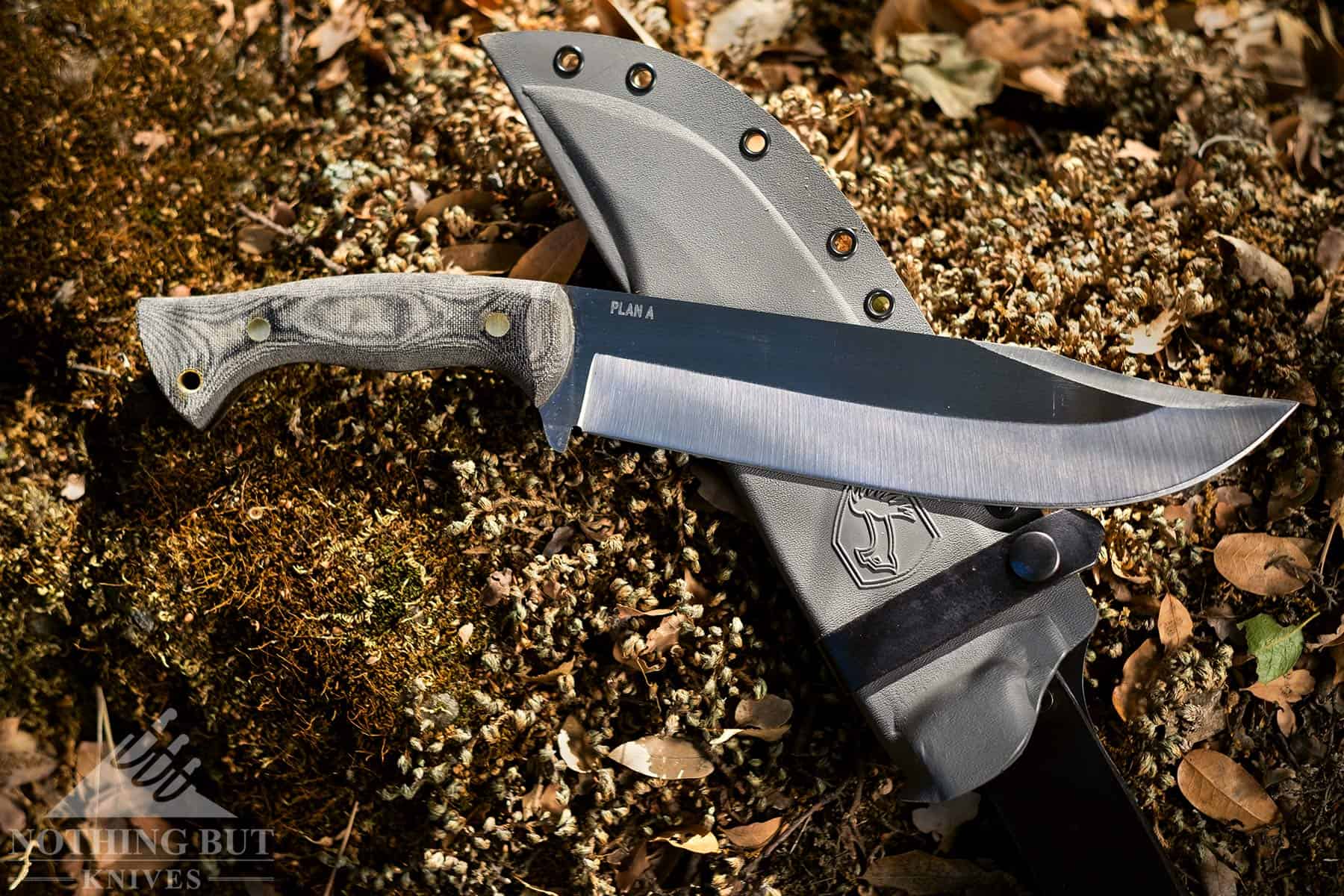
We are no strangers to Julio Diez, so the first thing I’ll direct you to is the Condor Plan A Bowie. It is arguably more practical if you’re going in for bushcraft work rather than trail blazing. It rides better on the belt, and has a finer edge geometry and slightly thinner blade stock, so there’s a bit of extra slicey-ness to it. A lot of Diez’ work would be worth an alternative look because most of his knives feel the same in the hand, although I’m pretty sure the Apex is the biggest thing he’s made to date.
If you want to go really cheap, you could roll with the Cold Steel Black Bear Bowie. The fit, finish, grind, balance and basically everything else is nowhere near a performing match for the Apex, but if all you want is a heavy chopper and the Apex is outside your range, the Black Bear can still get it done with a tough tool steel and a rubbery handle with a pretty good grip.
It’s The Knife I Never Knew I Needed

The Apex is heavy and pricey. That’s the only real criticism I have about it. It accomplishes everything the design is meant to do very well, though. It chops and slices and doesn’t fall apart if you abuse the hell out of it. So if you have the arms and wallet for this thing, I think it’s absolutely worth it.
It’s important that you’re honest with yourself about the Apex. There are practical reasons to get it, but there are more practical knives you can get for cheaper. Aside from the longevity of the Apex, what you gain with the purebred swinging curves on this is probably marginal, in the bigger picture, compared to a cheap, plastic-handled machete at Home Depot.
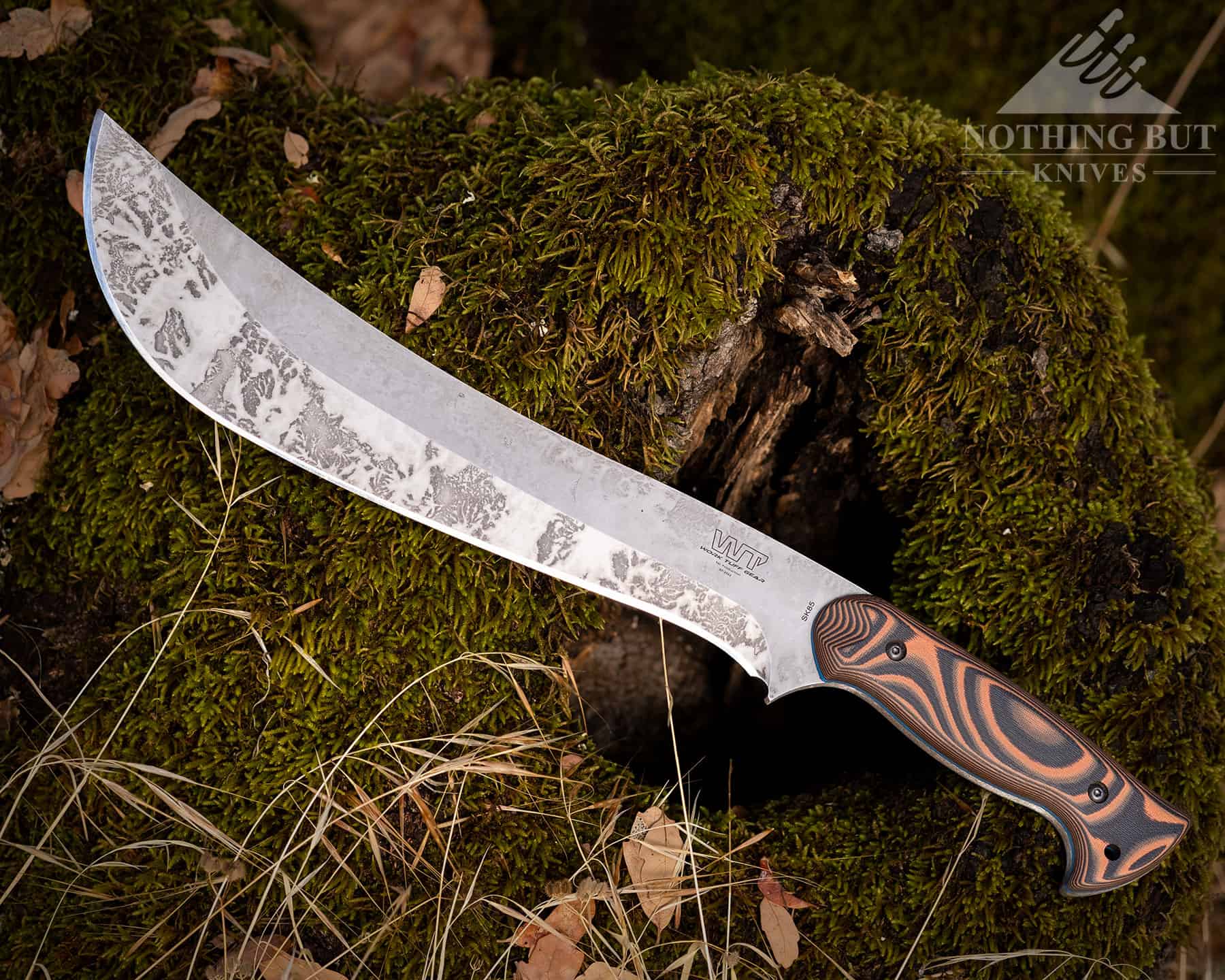
This is more about style and comfort than practicality. Nothing is going to chop and slice quite like the Apex. It feels like a machete that’s trying to deny its true calling as an axe because it wants to hang out with the bushcraft kids. It ends up being a fantastic chopper with a widespread utility so long as you have the arms to make it work.
The Work Tuff Gear Apex is a 2022 Drunken Hillbilly Award winner.

Awesome creation!
Thanks Bob.